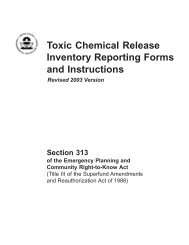Preventing Mold-Related Problems in the Indoor Workplace - Seton ...
Preventing Mold-Related Problems in the Indoor Workplace - Seton ...
Preventing Mold-Related Problems in the Indoor Workplace - Seton ...
You also want an ePaper? Increase the reach of your titles
YUMPU automatically turns print PDFs into web optimized ePapers that Google loves.
■ After a cleanup, to show that <strong>the</strong> types and concentrations<br />
of mold <strong>in</strong> <strong>the</strong> area are similar to background levels (17).<br />
Sampl<strong>in</strong>g for mold, mold spores, mycotox<strong>in</strong>s, and o<strong>the</strong>r<br />
bioaerosols are not part of a rout<strong>in</strong>e build<strong>in</strong>g evaluation.<br />
<strong>Mold</strong> sampl<strong>in</strong>g strategies<br />
Sampl<strong>in</strong>g and analysis of mold are complex and can become<br />
expensive. There is a lack of standard procedures for sampl<strong>in</strong>g and<br />
analysis (18). Sampl<strong>in</strong>g should be undertaken only after careful<br />
del<strong>in</strong>eation of <strong>the</strong> sampl<strong>in</strong>g goals. For assistance with mold<br />
sampl<strong>in</strong>g, consult an experienced health and safety professional.<br />
Health and safety professionals, work<strong>in</strong>g closely with an accredited<br />
environmental microbiology laboratory, can determ<strong>in</strong>e and document<br />
<strong>the</strong> details concern<strong>in</strong>g <strong>the</strong> necessary sampl<strong>in</strong>g strategy,<br />
<strong>in</strong>clud<strong>in</strong>g when and where to sample. Standardized methods, such<br />
as ACGIH, AIHA, NIOSH and OSHA methods, should be followed<br />
where available. Accredited laboratories that participate <strong>in</strong> <strong>the</strong><br />
AIHA Environmental Microbiology Proficiency Analytical Test<strong>in</strong>g<br />
(EMPAT) Program are listed on <strong>the</strong> AIHA website at http://www.aiha.org/<br />
LaboratoryServices/html/empat1.htm.<br />
The mean<strong>in</strong>g of mold sampl<strong>in</strong>g results that are <strong>in</strong><br />
CFU/m 2 and CFU/m 3<br />
Sampl<strong>in</strong>g results for viable (liv<strong>in</strong>g) microorganisms are presented<br />
as concentrations, and <strong>the</strong> units used will vary depend<strong>in</strong>g<br />
on <strong>the</strong> sample collection methods. Air sampl<strong>in</strong>g results are<br />
reported as colony-form<strong>in</strong>g units per cubic meter of air (CFU/m 3 ).<br />
Specialized sampl<strong>in</strong>g is reported <strong>in</strong> terms of <strong>the</strong> entity collected,<br />
i.e., if only spores were sampled, <strong>the</strong> results would be reported<br />
as spores/m 3 (19). Bulk samples may be reported as colony-form<strong>in</strong>g<br />
units per gram (CFU/g) of dust or material or colony-form<strong>in</strong>g units<br />
per milliliter (CFU/ml) of stagnant water or slime (20). Wipe sample<br />
results are reported as colony-form<strong>in</strong>g units per surface area such<br />
as CFU/m 2 or CFU/ft 2 . These units represent <strong>the</strong> culturable<br />
portion of mold concentrations only and do not quantify <strong>the</strong><br />
fragments and by-products of mold that may also exist.<br />
14
















